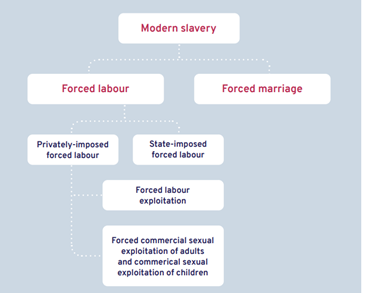Global Estimates of Modern Slavery
- 15 Sep 2022
The latest Global Estimates of Modern Slavery was published by the International Labour Organization (ILO), International Organization for Migration (IOM) and international human rights group Walk Free.

Major Findings
- In 2021, some 50 million people were living in modern slavery: 28 million in forced labour and 22 million in forced marriages.
- Compared to 2016 global estimates, 10 million more people were in modern slavery in 2021, with women and children disproportionately vulnerable.
- Modern slavery occurs in almost every country in the world, and cuts across ethnic, cultural and religious lines.
- More than half of all forced labour and a quarter of all forced marriages can be found in upper-middle income or high-income countries.
- Eighty-six per cent of forced labour cases are found in the private sector, with forced commercial sexual exploitation representing 23 per cent – almost four out of five victims of whom are females.
- State-imposed forced labour accounts for 14 per cent, of which nearly one in eight, or 3.3 million, are children.
- More than half are in commercial sexual exploitation.
|
What is Modern Slavery?
|
Forms of Modern Slavery
Forced Marriage
- In 2021, an estimated 22 million people were living in forced marriage, representing a 6.6 million increase over 2016 global estimates.
- The true incidence of forced marriage, particularly involving children aged 16 and younger, is likely far greater than estimates capture since they are based on a narrow definition that excludes some child marriages. They are considered forced because a minor cannot legally consent to marry.
- Forced marriages are highly context specific as they are linked to long-established patriarchal attitudes and practices.
- The report shows that more than 85 per cent are driven by family pressure.
- Based on regional population size, 65 per cent of forced marriages are found in Asia and the Pacific. Arab States have the highest prevalence, with 4.8 out of every 1,000 people in the region in a forced marriage.
Migrant Workers
- Migrant workers are over three times more likely to be in forced labour than other adult workers.
- While labour migration has a largely positive effect on individuals, households, communities and societies, irregular or poorly governed migration, or unfair and unethical recruitment practices render migrants particularly vulnerable.
What the Report Recommends for swiftly doing away with Modern Slavery?
- Improving and enforcing laws and labour inspections; ending State-imposed forced labour; stronger measures to combat forced labour and trafficking; extending social protection, and strengthening legal protections, including raising the legal age of marriage to 18.
- Addressing the increased risk of trafficking and forced labour for migrant workers, promoting fair and ethical recruitment, and greater support for women, girls and vulnerable individuals.
- Reducing the vulnerability of migrants to forced labour and trafficking in persons depends first and foremost on national policy and legal frameworks that respect, protect, and fulfil the human rights and fundamental freedoms of all migrants – and potential migrants – at all stages of the migration process, regardless of their migration status.
- All of society must work together to “reverse these shocking trends,’ including through implementation of the Global Compact on Migration.
|
Global Compact on Migration
|
Law Related to Slavery in India
- The Indian Slavery Act, 1843, also known as Act V of 1843 outlawed many economical transactions associated with slavery. The Act, banned slavery in India, made sale, and purchase of any person as a slave a punishable offence under the Indian Penal Code.
- Article 23 of Indian Constitution also mandates Prohibition of Trafficking & Forced Labour. It says, “Traffic in human beings and begar and other similar forms of forced labour are prohibited and any contravention of this provision shall be an offence punishable in accordance with law.”
- Bonded labour is defined in the Bonded Labour System (Abolition) Act of 1976 as a system of forced or partly forced labour in which a debtor gets an advance of cash or kind in return for his labour or service to the creditor.
|
Constitutional & Legislative Provisions related to Trafficking in India Trafficking in Human Beings or Persons is prohibited under the Constitution of India under Article 23 (1)
Other Acts/Provisions
Specific Sections in the IPC
Legislation by State Govts.
|




